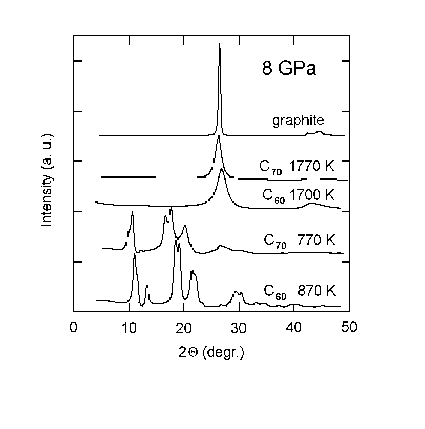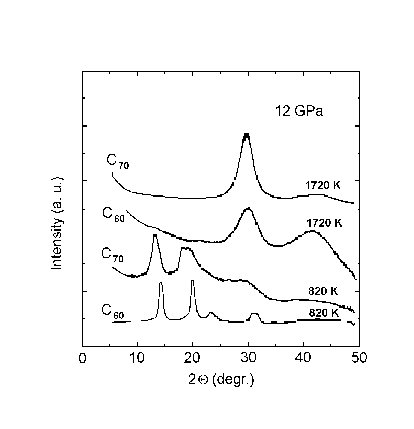
SUPERHARD PHASES OF C60- AND C70 - FULLERITES
V.D. Blank 1,2, N.R. Serebryanaya 1,2, G.A. Dubitsky 2, S.G. Buga 1,2, S.N. Sulyanov 3.
1 Institute of
Spectroscopy of RAS, 142092 Troitsk, Moscow region, Russia.
2 Research Centre for
Superhard Materials of Ministry for Science and Technologies of
Russia,7-a Centralnaya Str., Troitsk, Moscow region, 142092
Russia.
3 Shubnikov Institute
of Crystallography of RAS, Leninsky pr. 59, Moscow, 117333
Russia.
Keywords: C60 - and C70 -fullerites, high pressure, high temperature, phase transitions, hardness.
Superhard phases of C60 have been found in the material synthesized in the toroid-type apparatus at high pressures (up to 13 GPa) and high temperatures (up to 2100 K) [1]. It has been revealed that new carbon states on basis of C60 have polymerised structures and exhibit very interesting physical properties such as hardness eceeding diamond one, semiconductor properties and some others. A search of new superhard fullerene derivates forces to pay attention to C70 as the closest to C60. The comparison of structures of the C60 and C70 hard phases is represented.
The X-ray powder diffraction method and diffractometer Kard-6 with a flat proportional chamber on the fast delay lines are applied for the investigation of crystal structures of these phases. The Cu Ka-radiation and graphite monochromator are applied.
Two states (amorphous and crystalline) have been found in samples of the both kinds of fullerites. Crystalline states of the both fullerites are most alike at low pressures up to 8 GPa. The crystal structures are rhombohedral (R3 m) with a small rhombohedral distortion (a~560) for the both fullerites (Fig. 1). The diffraction patterns are poor, with few broad peaks, it is a two-dimensional (2D)-polymerised structure. The hardness is equal to that of glass. At the low temperatures up to 720 K the rhombohedral structure of C70 has no changes within the limits of precision at any pressure. The rhombohedral structure of C60 exists up to 8 GPa only.

Fig. 1. Diffraction patterns of C60- and C70-samples after treatement at 8 GPa and different temperatures.
At P>=9.5 GPa and T>=750 K there are different structures for C60 and C70: quazy-face-centred cubic (with orthorhombic distortion) and tetragonal respectively (Fig.2). Diffraction peaks are very broad, particularly for C70-phases (FWHM>0.9o). There are three-dimensional (3D)-polymerised structures for the both fullerites, the shortest distanse between molecular centers attaines the value 1.6-1.5 Å. AT P>12.5 GPa, the unit-cell cubic C60- parameter is equal to 12.1 Å, and the analysis of intensities of this structure of C60 supposes the formation of the second fullerite-like cluster in the octahedral cavities of fcc - structure. The unit-cell parameters of all crystalline phases of both fullerites are represented. There are hard phases: the hardness is equal to hardness of a (100) face of diamond.
Crystalline state remaines up to 900-1000 K for all the pressure interval, then fullerite cages deform producting different 3D-polymerised disordered structures. The cross-linked layered disordered structure is observed for the both fulllerites up to 9.5GPa and above 900 K. These diffraction patterns are similar to that of graphite, but the (002)-reflection moves to large 2-angles and its FWHM is approximately equal to 1.5o, the (100) and (101) merge into one halo. The hardness is higher than that of graphite, its value is in the range between sapphire and cubic BN.
At P>=12.5 GPa
the (002)-displacement increases and interplanar space relation
becomes a cubic one with a~6.0 Å (Fig 2). The hardness is equal
to that of the (100) face of diamond. At 13 GPa only one halo (d
=2.13-2.18 Å) remains in the observed interval up to 500
2q,
it is the hardest phase of C60 with hardness exceeds
that of the (111) face of diamond. The P-T phase diagram of C60
is represented. 
Fig.2. Diffraction patterns of C60-
and C70-samples after treatement at 12 GPa and
different temperatures.
The main difference between
diffraction patterns of new phases of C60 and C70
is grade of disorder. Diffraction patterns of C70 have
more broad peaks than those of C60 and they become
amorphous at lower temperature than that for C60. The
hardest crystalline C60 has the highest symmetry
(Fm3m) and such C70 is a tetragonal.
1. Blank V.D., Buga S.G., Serebryanaya N.R., et al. Phys.Lett., 1996, A220, 149.